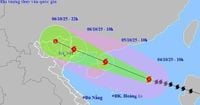As Typhoon Matmo—designated as typhoon number 11—barrels toward northern Vietnam, local authorities in Ninh Binh and Hai Phong provinces have launched a sweeping, coordinated response to protect lives, property, and vital infrastructure. The storm, clocked at 17:00 on October 3, 2025, by the National Center for Hydro-Meteorological Forecasting, entered the eastern sea area of the northern East Sea with winds near its center reaching a formidable 89–102 km/h, gusting up to level 13. Matmo’s west-northwest trajectory, at 25 km/h, has set emergency plans in motion across coastal communities bracing for possible devastation.
Following the conclusions set forth by Deputy Prime Minister Tran Hong Ha, the People’s Committee of Ninh Binh province issued urgent directives to local authorities and relevant agencies, emphasizing a proactive, all-hands-on-deck approach. The instructions were clear: secure homes, prune trees, and shield agricultural and aquacultural operations to minimize potential damage. Evacuation plans were meticulously prepared for areas at risk of landslides, deep flooding, and vulnerable older urban apartments, with the aim of ensuring the absolute safety of all residents.
“We have to be ready for anything,” said a Ninh Binh official, echoing the urgency felt throughout the region. According to the provincial government, strict inspection and protection of dikes and embankments—especially at sites with unresolved issues or ongoing construction, such as the Con Tron sea dike, Hai Thinh, Thinh Long embankments, and Binh Minh III and IV sea dikes—were prioritized. The region’s ‘4 on the spot’ principle, which calls for immediate deployment of personnel, materials, and equipment at the local level, was invoked to ensure rapid detection and handling of any incidents from the very first signs of trouble.
Relevant departments received orders to guarantee the safety of dikes, reservoirs, irrigation systems, and agricultural production. These agencies coordinated efforts to repair any dike incidents caused by the typhoon or flooding, and to maintain tight management of vessels leaving port. Timely updates on the typhoon’s position, movement, and developments were disseminated to ensure that all vessels could seek safe mooring well before the storm’s arrival.
The province’s Military Command and Police were mobilized, ready to deploy forces and equipment for rescue and relief operations at a moment’s notice. Local media, including Ninh Binh’s press, radio, and television outlets, ramped up coverage of the typhoon’s progress, offering residents practical guidance on disaster prevention and mitigation. All units were instructed to maintain direct monitoring and continuous reporting to the Provincial Civil Defense Command via the Department of Agriculture and Environment, ensuring that no development would go unnoticed or unaddressed.
Meanwhile, in Hai Phong, a city renowned for its bustling port and vibrant coastal life, the response was equally robust. By 10:00 on October 4, 2025, the Hai Phong Border Guard Command had coordinated the inspection and notification for 1,603 vessels with 4,488 workers—ranging from fishing boats and passenger ships to cargo vessels and floating aquaculture cages. Of these, 1,322 vessels carrying 3,402 workers had already returned to port and moored safely, while 281 vessels remained at sea, closely monitoring the typhoon’s approach.
Special attention was paid to the Cat Hai and Bach Long Vi zones. In Cat Hai, vessel owners, fishermen, and coastal aquaculture farms were promptly informed of the typhoon’s trajectory and instructed to moor their vessels as per safety regulations. In Bach Long Vi, regular communication with vessel owners and fishermen was maintained to manage any adverse scenarios. Authorities also prepared evacuation plans for eight households living near the water’s edge, in anticipation of possible storm surges or flooding.
The Department of Agriculture and Environment in Hai Phong mobilized 100% of its dike management forces, totaling 160 personnel at district levels, to inspect, guide, and support localities in conducting round-the-clock patrols and monitoring dikes at flood warning levels. Dike management units were directed to organize comprehensive inspections of the city’s dike systems, while local patrol teams were trained to detect and address any dike, embankment, or gate incidents immediately, again following the ‘four on the spot’ doctrine.
Coordination with localities enabled authorities to identify specific areas at risk of flooding. Emergency drainage operations were organized to protect both agricultural output and residential areas, especially where heavy rain was forecast. One-member limited liability companies operating irrigation works were ordered to inspect, repair, and prepare resources and equipment to ensure the safety of drainage gates and to prevent flooding in key areas. “Our priority is to make sure every gate and embankment holds,” a city engineer noted, underscoring the gravity of the situation.
The Hai Phong Military Command and City Police joined forces to prepare comprehensive rescue and relief plans, ensuring that personnel and equipment could be deployed instantly in the event of an emergency. All localities, agencies, and units were required to update their response status regularly and to report any incidents or challenges arising during the implementation of these emergency measures.
In both provinces, the media’s role has been vital. Local outlets have provided residents with timely updates and practical advice on evacuation procedures, storm preparedness, and post-typhoon recovery. This information blitz, officials say, is designed to empower citizens to take preventive action and reduce the risk of injury or loss.
What stands out in this coordinated response is the emphasis on preparation, communication, and community involvement. From the highest levels of government down to the smallest village, the message is the same: vigilance and readiness are the best defenses against nature’s fury. The ‘four on the spot’ approach—ensuring that every locality has the people, materials, equipment, and command structure it needs to respond instantly—has become a cornerstone of Vietnam’s disaster management philosophy, particularly in regions vulnerable to typhoons and flooding.
As Typhoon Matmo continues its march toward the northern coast, the coming hours and days will test the resilience of these communities and the effectiveness of their meticulous planning. But if the flurry of activity, the mobilization of resources, and the spirit of collective action are any indication, Ninh Binh and Hai Phong are as ready as they can be for whatever the storm may bring.
In the face of uncertainty, it’s the small acts—tying down a fishing boat, checking a dike for cracks, preparing an evacuation plan—that add up to a community’s best chance at weathering the storm safely.





